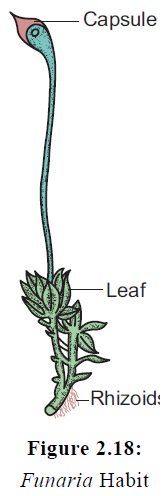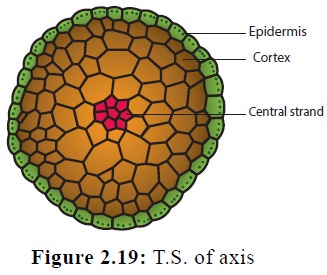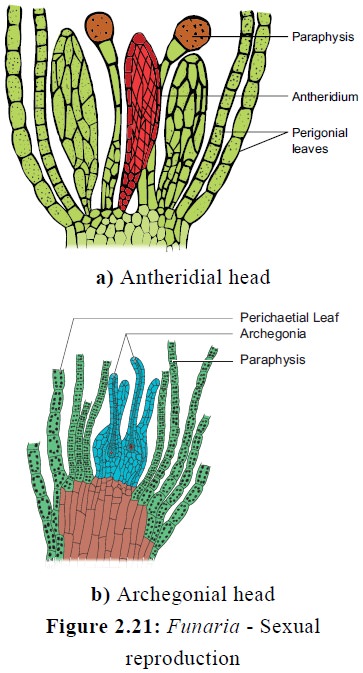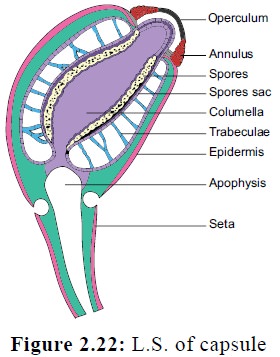Chapter: 11th Botany : Chapter 2 : Plant Kingdom
Funaria : Internal structure, Reproduction - Bryophytes
![]()
![]()
![]() Funaria
Funaria
Class – Bryopsida
Order- Funariales
Family – Funariaceae
Genus – Funaria
Funaria is
commonly called ‘cord moss’. It is
distributed throughout the world. Funaria
hygrometrica is the common species.
It grows in close tufts on rocks, trunks of trees, damp walls and damp soils.
They help in the process of soil formation (Pedogenesis).

External features
The plant body is a gametophyte. It is small, 1 to
3 cm high and consists of slender erect radial stem covered with small, simple
leaf like structures arranged in a spiral manner. The gametophyte is attached
to the substratum by means of multicellular rhizoids. They are characterized by
the presence of oblique septa. The leaves are simple, sessile ovate and have
broad membranous base and pointed apex.
Internal structure
T.S. of axis
The T.S. of axis shows the presence of epidermis,
cortex and central cylinder. The epidermis is the outermost layer and contain
chloroplast bearing cells. The cortex is made up of parenchymatous tissue. The
cells of the young axis bear chloroplasts. In mature stems the outermost cells
become reddish brown colour and become thick walled. Small leaf traces are also
noticed. The central cylinder is made up of long, narrow, thin walled,
colourless cells which lack protoplasts. They help in the conduction of water
and minerals.

T.S. of leaf
A well defined midrib is present. It consists of
several layers of cells but the lateral ‘wing’ or lamina is made up of single
layer of thin walled cells which are rich in chloroplasts. Midrib contains
small strands of slightly thickened narrow cells which help in conduction.
Reproduction
Funaria reproduces
by vegetative and sexual methods.
Vegetative reproduction
Vegetative reproduction takes place by the
following methods (Figure 2.20):
1.
Fragmentation of primary protonema,
2.
Formation of secondary protonema from any part of
the gametophyte
3.
Formation of gemmae on terminal cells of the
protonema.
4. Development of Bulbils on the rhizoids.

Sexual reproduction
Funaria is
monoecious the male and female
reproductive sex organs are borne on different branches of the same
gametophyte. Male sex organ is antheridium and it is formed in groups on the
antheridial branch.They are enclosed by special leaves called perigonial leaves. A large number of
long multicellular hairs interspersed with antherdia called paraphysis are also present. They contain chloroplast and are involved
in photosynthesis. They protect antheridial head from by minimizing
transpiration, hold water between them through capillary action and secrete
mucilage which helps in the liberation of antherozoids. Each antheridium is
protected by single layer of jacket. It encloses a large mass of androcytes.
The androcytes transform in to biflagellate antherozoids (Figure 2.21).

The female sex organ are the archegonia and are
borne in clusters on the archegonial branch. Archegonial branches arise
laterally at the base of the male branch. They are surrounded by perichaetial leaves. Paraphyses are also present. Each archegonium is flask shaped and is distinguished into a large
venter and long neck region. The venter contains venter canal cell and egg. The
neck contain neck canal cells (Figure 2.21). Water is essential for fertilization.
Rain drops help in the transfer of antherozoids from antheridial head to
archegonial head. The antherozoids are attracted to the archegonium through chemotaxis. A large number of
antherozoids enter the neck of the
archegonium but only one fuses with the egg to form a diploid zygote. The
diploid zygote represents the first cell of sporophytic generation and divides
to form a sporophyte.
Structure of Sporophyte or capsule
The structure of mature sporophyte of Funaria is complex. The sporophyte is
differentiated into foot, seta and capsule (Figure 2.22) . The foot is small,
conical and is embedded in the gametophyte.

The seta is long, slender and conducts water and nutrients
to the capsule . The capsule is differentiated into apophysis, theca proper and
operculum. The cells constituting the wall of the capsule contain chloroplasts
in them. The apophysis is the lowermost sterile region and connects the capsule
with seta. The epidermis contains stomata which help in exchange of gases. The
cells of the apophysis are photosynthetic, hence the sporophyte of Funaria partially depends on the
gametophyte. The theca proper is the middle part and is fertile region of the
capsule. It consists of a central columella surrounded by spore sac. The spore
sac is surrounded by a single cylindrical air sac traversed by delicate
filaments made up of parenchyma cells called trabeculae. The trabeculae extend from the outer wall of the spore
sac to the innermost layer of the capsule wall. The spore sac contains spore
mother cells which undergo meiotic division to produce haploid spores. The
apical region consists of the operculum and peristome. The operculum is the lid
of the capsule and comes out as a circular cup shaped lid after the dehiscence
of the capsule. The peristome has one or two rows of thickened, tooth like
projections found on the top of the capsule. They are hygroscopic and help in
the dispersal of the spores. During favourble conditions the spores germinate to
produce thread like green branched structure called protonema. It produces
rhizoids and number of lateral buds which develop into new plants. In the life
cycle of Funaria the haploid
gametophytic phase (n)alternates with diploid sporophytic phase (2n) and shows
alternation of generation (Figure 2.23).

Related Topics